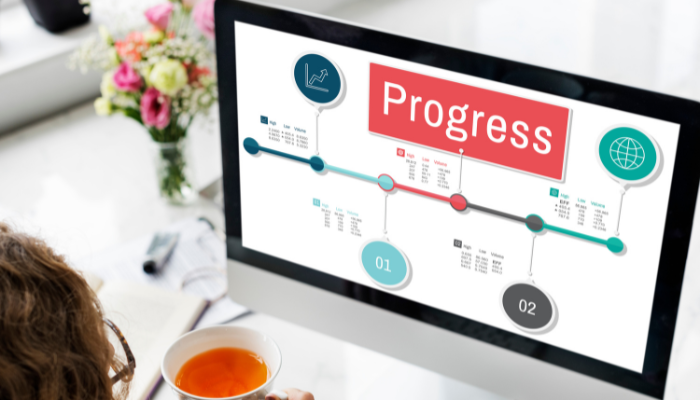If you don’t know where you’re going, any road will get you there.” – Lewis Carroll.
Having said that, by establishing a structured roadmap, you avoid the pitfalls of aimless progress and ensure that each step is meaningful and purpose-driven. Creating a roadmap is a key task that can make or break a product’s success. A clear and structured roadmap synchronizes team efforts, prioritizes development, and communicates strategic goals clearly to stakeholders.
Studies show that 94% of people pay attention to a website or app’s design before reading a single word. That’s huge! It means your roadmap’s visual appeal matters just as much as the content itself. Visual roadmaps not only align teams more effectively, but they also help you communicate the big picture in a way that’s easy to grasp.
In this blog, you’ll discover how to create an effective roadmap that steers your product’s journey, aligns your team, and clearly communicates your vision to stakeholders. By the end, you’ll be equipped to build a roadmap that keeps everyone focused on the same goals.
So, let’s get into it and set your product on the path to success!
What is a Product Roadmap?
A product roadmap is a strategic, visual document that outlines the vision, direction, and priorities for a product over time. It serves as a communication tool that aligns stakeholders—such as product teams, marketing, and sales—around the product strategy and execution plan.
The key elements of a product roadmap are:
- Product goals: Clearly defined objectives the product aims to achieve.
- Features to build: Specific functionalities or updates planned for development.
- Dates or timeframes: Target deadlines or milestones for feature releases.
- Metrics for progress: Measurable indicators used to track and assess the product’s success in meeting its goals.
Note: Stakeholders play a crucial role in the development and success of a product roadmap. They encompass a wide range of individuals and groups, including internal teams (like design, engineering, sales, and marketing) and external entities (such as customers and partners).
Now that you understand what a product roadmap is, let’s take a look at why using a visual approach is so valuable.
Why Are Visual Product Roadmaps Important?
A visual product roadmap is more than just a plan on paper; it’s a dynamic tool that brings clarity and focus to the product development process. It charts the path from a promising idea to a polished product, ensuring everyone understands the journey. Here’s how a visual roadmap works:
- It visually maps out how the product will evolve over time.
- Ensures that every team member knows what to focus on and why it matters.
- Breaks down complex ideas into an easy-to-understand format that’s accessible to everyone.
- Reduces confusion by making sure everyone’s on the same page.
- Helps teams stay agile and responsive to market shifts or new technologies.
- Becomes an essential guide for turning strategic goals into actionable steps.
To effectively manage the complexities of product development, it’s essential to utilize the right roadmap that aligns with your strategic goals. Let’s take a closer look at each type.
Also Read: Developing Your Product Strategy Framework: Essential Steps
Types of Product Roadmaps
Each roadmap serves a unique purpose and helps guide decision-making throughout product development. Here’s a closer look at the various types:
- Strategy Roadmap: Focuses on long-term vision and strategic goals, aligning product development with overarching business objectives. It is ideal for new products or setting long-term directions.
- Feature Roadmap: Provides a timeline for developing specific features, prioritizing them based on customer feedback and market demands. It’s the best for managing feature development but less effective for long-term planning.
- Technology Roadmap: Concentrates on technological advancements and infrastructure improvements needed to support the product. It’s mainly helpful in planning technology upgrades but not suited for feature-specific planning.
- Market Roadmap: Centers on market trends, customer needs, and competitive analysis to ensure product relevance. Ideal for staying ahead of market changes but less useful for internal development.
- Development Roadmap: Highlights key development activities and iterations, often used in Agile environments for sprint planning. It is best for managing Agile cycles but not suitable for long-term strategic planning.
- Portfolio Roadmap: Communicates the strategy of a product line across multiple products, showing how they relate to business objectives. It is essential in companies with multiple products.
- Visionary Roadmap: This document outlines aspirational goals and innovative ideas to inspire stakeholders. It is useful for guiding long-term planning but may lack immediate actionable details.
- Goal-based Roadmap: Structures planning around specific business goals, ensuring that product features align with measurable objectives at each stage of development.
- Outcome-based Roadmap: Focuses on the impact or value delivered rather than specific features, aligning product development with desired outcomes for users.
- Agile Roadmap: These roadmaps are dynamic and iterative, adapting to changing requirements and feedback while emphasizing frequent value delivery in small increments.
With a strong foundation in why a visual product roadmap is essential, let’s look at the key benefits it offers to ensure your product’s success.
The Benefits of Visual Product Roadmaps
Why should you invest time in creating a visual product roadmap? Because it pays off in ways you can’t imagine.
1. Enhanced Communication
Clarity and Engagement
Visual roadmaps are powerful tools for presenting product strategies in a clear and engaging manner. They transform complex information into a visual format that is easy to understand, allowing stakeholders to quickly grasp the product’s vision and direction. This clarity is especially useful in meetings, where a shared visual reference can lead to more effective discussions.
Single Source of Truth
Consolidating information into a single visual document reduces confusion caused by multiple versions of static documents. This centralized approach ensures that all team members are working with the latest updates and priorities, fostering better coordination and alignment across the team.
For Example:
If your company has been facing challenges with miscommunication between your product and sales teams, a visual roadmap could be a game-changer. Perhaps your sales team has been promising clients features that aren’t yet available, leading to frustrated customers and tension with the product team.
By implementing a visual roadmap, your sales team can easily see when specific features will be developed and ready for release. This transparency allows them to set realistic expectations with clients, reducing over-promising and misalignment between teams. As a result, both teams stay on the same page, improving client satisfaction and internal collaboration.
2. Strategic Alignment
Common Understanding
A visual roadmap aligns various teams—such as development, marketing, and sales—around shared goals. It provides a clear picture of how short-term initiatives connect to long-term business objectives, ensuring a unified approach to product development. This common understanding helps in maintaining focus and reducing misunderstandings.
Prioritization of Efforts
It helps in prioritizing features and initiatives based on strategic importance and customer needs. This structured prioritization ensures that teams focus on what matters most, allowing resources to be allocated effectively to meet organizational goals.
For Example:
Imagine your company is preparing for a major product launch. By using a visual roadmap, your development, marketing, and sales teams can see exactly when new features will be ready, and how they align with your broader strategy.
For instance, if you’re an e-commerce business gearing up for a holiday sale, the roadmap allows the marketing team to plan promotions in sync with feature releases, the development team to focus on critical updates, and customer support to prepare for potential inquiries. This alignment ensures that all departments are working together toward a common goal, preventing last-minute chaos and boosting team engagement as everyone sees their role in driving success.
3. Improved Decision-Making
Data-Driven Insights
By offering a framework for analyzing customer feedback, market trends, and internal priorities, visual roadmaps enhance decision-making. This data-driven approach allows teams to make informed choices about product features and improvements, aligning them closely with market demands.
Flexibility and Adaptability
Unlike static plans, visual roadmaps are adaptable and can be updated as market conditions change or new opportunities arise. This flexibility ensures that the product strategy remains relevant and responsive to shifts in customer expectations and market dynamics.
For Example:
If your company is a health tech firm, where various departments frequently submit ad-hoc feature requests, each pushing for immediate attention. Without a clear structure, it’s easy for the engineering team to get overwhelmed and lose focus on what truly matters.
However, after introducing a visual roadmap, your team now has a transparent, organized view of which features are in progress and which are planned for the future. This visibility allows everyone to see the top-priority tasks at a glance, helping the engineering team stay focused on high-impact features without getting sidetracked by lower-priority requests.
4. Track Progress Like a Pro
You’ve got big plans, but how do you ensure you’re on track? A visual product roadmap is a live tracker that updates everyone on progress. It’s like a GPS that ensures you’re heading in the right direction.
For Example:
Your software company is developing a new platform upgrade with features that must be delivered by a certain date for a major client. If an issue arises—such as a delay in integrating a key payment system—the visual roadmap allows your product manager to immediately spot the holdup. By reprioritizing tasks, like moving up the delivery of other features that don’t depend on the integration, the team can still meet the client’s overall deadline. This dynamic adjustment helps avoid missed timelines and ensures everyone stays aligned on priorities.
Interested in learning more about how design thinking can enhance your approach to creating visual product roadmaps? Join Codewave’s Design Thinking Workshop to discover how to incorporate user-centered strategies into your product planning.
Now that we’ve covered the benefits. We are ready to create a visual product roadmap that people will actually care about. Let’s go.
Steps to Create a Visual Product Roadmap
By following these simple steps, you can craft an outstanding visual roadmap that will ensure your next product launch stays on course.
Step 1: Start with Your Product Strategy
Before you start plotting, you need to know where you’re going. Define your product strategy with clarity.
Key Questions to Define Your Strategy:
- What problem does your product solve?
- Who is it for?
- What’s your end goal?
Start with these questions and let them guide your roadmap creation.
For Instance:
If your product is designed to improve customer onboarding for SaaS platforms, your roadmap should clearly show features that address common onboarding pain points. These might include:
- A simplified setup process
- A built-in customer support feature
- Integration with popular tools that SaaS customers frequently use
Step 2: Know Your “Why”
The “why” is the heartbeat of your product roadmap.
- Why does your product exist?
- Why should customers care?
Answering these questions ensures that your roadmap is built on a solid foundation.
For Instance:
Let’s say your product aims to streamline B2B communication. In this case, your roadmap should focus on prioritizing features like:
- Chat integrations with CRM systems
- Automated communication workflows
- Detailed user analytics to measure engagement
Ready to bring your vision to life? Let Codewave streamline the process and kick-start your roadmap. Begin with Product Scope Creation and watch your ideas turn into reality!
Step 3: Customize for Your Audience (Because One Size Doesn’t Fit All)
Not all stakeholders speak the same language. Your product team might want details, while executives wish to see the big picture. Customize your visual product roadmap for each audience, ensuring it resonates with everyone involved.
For Instance:
For a stakeholder presentation, you might show how the product’s new features address user pain points and fit into a larger release timeline. But for your internal team, break down each release into specific features, tasks, and deadlines.
Still confused about how to create a visual product roadmap that works for everyone? Codewave’s New Product Development can help you simplify the process—breaking down features, timelines, and tasks with ease. Let’s bring your product vision to life!
Step 4: Combine Features and Releases for a Clean, Unified View
Don’t get lost in the details. Combine releases and features to provide a unified view of your product journey. This will help stakeholders see the big picture without getting overwhelmed by the details.
For Instance:
Let’s say you’re planning a major release in the spring that includes three key updates: a redesigned user interface, new security features, and integration with third-party tools. Instead of listing each feature separately, group them together under one spring release. This gives stakeholders a clear, cohesive view of the product’s development, showing the overall impact without overwhelming them with too many details.
That’s where Codewave comes in to lighten the load. We focus on design thinking-driven product development, ensuring that your product strategy goes beyond theoretical concepts and transforms into a market-ready solution that truly connects with your target audience.
Now that you’ve set the foundation, it’s time to turn your plan into something everyone can follow. So, let’s take the next step and start presenting the roadmap—where your vision starts taking shape.
Presenting the Roadmap
A roadmap is only as good as how you present it. Here’s how to make sure yours stands out.
Start with the Vision and Goals
Articulate the Vision
Kick off by sharing a clear and inspiring vision for your product. This helps your audience understand the “why” behind your roadmap. Use vivid language and storytelling to show the impact your product can make.
Strategy: Start by explaining the purpose behind your product. Use compelling language and storytelling to make the vision relatable. Instead of being vague, give a real-world example of how the product will impact users. For example, “Imagine a workspace where team members can collaborate effortlessly, never miss a deadline, and always stay aligned.”
Define Specific Goals
Break down the vision into clear, achievable goals. These targets act as stepping stones, helping you track progress and set expectations along the way.
Strategy: Be specific about the outcomes. For example, “Our goal is to improve team efficiency by 25% through the implementation of real-time collaboration tools.” Defining these goals helps track progress and set clear expectations from the outset.
Structure Your Presentation
Logical Flow
Organize your presentation into sections with headings and subheadings, starting with a quick agenda to outline what you’ll cover. This structure helps guide your audience smoothly through the roadmap.
Strategy: Divide your presentation into clearly defined sections with headings and subheadings. Start with a quick agenda to outline the key points you will cover. This ensures that the audience knows what to expect and helps maintain a smooth flow of information.
Focus on Themes, Not Just Features
Rather than listing out features, group them into broader themes. This thematic approach highlights the big-picture strategy, making it easier for everyone to see where you’re headed.
Strategy: Group features into broader themes, such as “improved collaboration,” “enhanced security,” or “faster performance.” This helps align the audience with the overall strategy instead of getting bogged down in small details. Themes make it easier to see the bigger picture and understand the product’s direction.
Tailor Your Content to the Audience
Know Your Audience
Different stakeholders have different priorities—executives want to see the strategic alignment, while the technical team cares about implementation. Tailoring your message ensures that everyone stays engaged.
Strategy: Adjust your presentation to match the priorities of different stakeholders. For example, when talking to executives, emphasize strategic alignment and business outcomes. For the technical team, focus on the features and implementation process. Customizing your message ensures that everyone stays engaged and gets the information most relevant to them.
Customize Visuals for Clarity
Incorporate clear diagrams, charts, and color coding to differentiate themes and objectives. Well-designed visuals help break down complex information, making it easier for your audience to follow along.
Strategy: Use simple, well-designed visuals to support your points. Diagrams, Gantt charts, and color-coded timelines can break down complex information into digestible pieces. For instance, highlight different phases of development with distinct colors to show progress over time.
Discuss Timeframes and Milestones
Highlight Key Milestones
Guide your audience through critical milestones and deliverables, explaining how each contributes to the overall vision. Address any dependencies or challenges that could impact progress.
Strategy: Clearly point out important milestones and explain how they contribute to achieving the overall vision. Mention specific deliverables and their deadlines. If there are any dependencies or potential roadblocks, address them proactively to build trust with your audience.
Engage Your Audience
Interactive Elements
Use interactive elements like Q&A sessions or live demos to keep your audience engaged. This interactivity fosters a deeper understanding of the roadmap and keeps the conversation lively.
Strategy: Keep the audience involved by adding interactive elements such as Q&A sessions, live demos, or polls. For example, after explaining a milestone, ask the audience for input on potential challenges they foresee. This interaction keeps the audience focused and promotes better engagement.
Encourage Feedback
Wrap up with time for questions and feedback. This shows that you value stakeholder input and helps clarify any lingering uncertainties about the roadmap.
Strategy: Always reserve time for feedback at the end of your presentation. Invite questions and listen to stakeholder concerns. This not only shows that you value their input but also helps clarify any remaining uncertainties. For example, you could say, “We’d love to hear your thoughts on the timeline or any potential risks we should consider.”
Also Read: Understanding the New Product Introduction Process in 6 ways
Now that we’ve covered how to present a roadmap, let’s move on to some actionable tips to make your visual product roadmap stand out.
Tips to Make Your Visual Product Roadmap Stand Out
With these practical tips, let’s make your visual product roadmap as effective as possible.
- Use Color
Colors aren’t just pretty—they’re powerful. Use them to differentiate themes, tasks, and priorities, making your roadmap more engaging and easier to understand.
- Use Large Fonts
Your roadmap should be easy to read from across the room. Make sure your message gets across using big, bold fonts.
- Keep It High-Level
The more straightforward your roadmap, the more powerful it becomes. Don’t clutter it with too much detail.
- Link to Relevant Data
Include links to relevant data or documents. This keeps your roadmap clean while providing access to in-depth information for those who need it.
- Keep It Simple for Effective Communication
Simplicity is the ultimate sophistication. Keep your visual product roadmap simple to ensure it communicates effectively without overwhelming your audience.
We at Codewave will support you from concept to prototype to a market-ready product, incorporating user feedback at every step. Start today and ensure your roadmap meets the needs of everyone involved—because one size definitely doesn’t fit all!
With these practical tips in mind, your visual product roadmap can become a powerful communication tool that drives alignment and clarity across your team. To take things a step further, having the right tools at your disposal can make creating and managing your roadmap even more effective.
Let’s take a look at some of the top tools available for visualizing product roadmaps.
Top Tools for Visualizing Product Roadmaps
Tools make all the difference. Here are the top ones to consider:
Effectively visualizing a product roadmap is essential for aligning teams, tracking progress, and ensuring a product’s success. The right tools make all the difference, enabling teams to communicate their strategy, prioritize features, and manage feedback. Here are the top tools you should consider when creating or refining your product roadmap:
1. Aha! Roadmaps
Aha! Roadmaps is a premium tool that’s part of the Aha! suite, designed to support product strategy and planning. It offers a comprehensive platform with customizable templates and advanced features.
- Key Features:
- Customizable templates for roadmaps.
- Prioritization scorecards to focus on high-impact features.
- Easy sharing of roadmaps via URLs or presentations.
- Integrations: Compatible with Jira, GitHub, and Azure DevOps.
- Ideal For: Teams that require in-depth strategic planning with robust feedback and prioritization tools.
2. Roadmunk
Roadmunk is built with a focus on integrating customer feedback into the product development process. It helps teams visualize and manage feedback directly on their roadmap.
- Key Features:
- Timeline and swimlane views for different roadmap perspectives.
- Centralized feedback dashboard for prioritizing features based on user needs.
- Integrations: Syncs with Jira and Azure DevOps to keep everything up to date.
- Ideal For: Teams that want to prioritize product features based on customer feedback and need a user-centric roadmap.
3. ProductPlan
ProductPlan is known for its intuitive drag-and-drop interface, making it easy to visualize and share product roadmaps with stakeholders.
- Key Features:
- Multiple views: timeline, list, and table.
- Unlimited viewer accounts, allowing easy sharing of roadmaps via private links.
- Integrations: Supports spreadsheet imports and integrations with popular tools like Jira and Slack.
- Ideal For: Teams that prioritize ease of use, collaboration, and frequent updates to their roadmap.
4. Trello
While primarily a project management tool, Trello’s flexible board layout can be adapted for roadmap visualization. It’s simple yet effective for smaller teams.
- Key Features:
- Board layout with customizable lists and cards.
- Roadmap templates to help structure your process.
- Integrations: Syncs with other tools such as Slack, GitHub, and Google Drive.
- Ideal For: Smaller teams or those already using Trello who need a lightweight, adaptable roadmap solution.
5. Airfocus
Airfocus is a premium product management tool that provides powerful features for roadmap creation and prioritization. It’s especially useful for managing multiple products.
- Key Features:
- Customizable views, including boards and timelines.
- Advanced prioritization options for feature planning.
- Consolidates multiple roadmaps into one overarching view.
- Integrations: API access for custom integrations, along with integrations with tools like Jira and Trello.
- Ideal For: Teams managing multiple products or needing advanced prioritization features to make informed decisions.
6. Craft.io
Craft.io is an all-in-one product management platform that ties objectives and key results (OKRs) directly to the roadmap. It’s ideal for teams looking to align their product strategy with their overall business goals.
- Key Features:
- Direct connection of objectives to roadmap items.
- Custom views for different stakeholders, such as leadership or engineering.
- Ideal For: Teams needing a comprehensive product management solution that connects strategic goals to roadmap execution.
7. FigJam
FigJam is a collaborative whiteboard platform by Figma, designed to enhance brainstorming and planning sessions. It’s particularly useful for early-stage roadmapping and ideation.
- Key Features:
- Multiple team members can brainstorm and contribute at the same time on the same canvas.
- Perfect for quick ideas, feedback, and sketching out concepts.
- Seamlessly transition from brainstorming in FigJam to designing in Figma.
- Ideal For: Teams that prioritize collaboration and brainstorming, especially in the early stages of product development.
With the right approach, you’re not just planning for digital change—you’re creating a structured, visual journey that will guide your organization toward its future in the digital age. For more insights on how to navigate this process, check out our Digital Transformation offerings.
Now that you’ve explored the top tools for visualizing your product roadmap, it’s time to focus on best practices that will help you create a roadmap that drives real results.
Best Practices for Effective Roadmaps
Building and maintaining product roadmaps is an ongoing process that requires collaboration and alignment within your product team. Here are a few simple strategies to ensure success:
- Include only the essential details tailored to your audience’s needs.
- Balance short-term tactics with long-term goals to provide a clear path forward.
- Regularly review and update the roadmap as plans evolve.
- Ensure everyone has access to the roadmap and reviews it consistently.
- Maintain strong communication with stakeholders at all levels to keep everyone aligned.
At Codewave, our team of specialists is committed to guiding you through every stage of the product development process. From defining a compelling product vision to simplifying user research and testing, we ensure you have the insights and support needed for success.
Conclusion
It’s clear that visuals have the power to improve communication and comprehension in ways that text alone simply can’t match. A visual roadmap not only provides clarity and alignment but also engages teams and stakeholders, helping to keep your product strategy on track. Whether you’re just starting your product journey or looking to refine your process, a well-structured visual product roadmap is an invaluable asset.
With a solid roadmap in place, you not only set the stage for successful product launches but also cultivate a culture of collaboration and innovation. Remember, the journey from idea to market-ready product can be complex, but with the right support, it can also be incredibly rewarding.
So, why wait? Let’s start building a roadmap that truly reflects your goals and ambitions!
Ready to transform your product development process? Partner with Codewave and watch your ideas come to life, from concept to market-ready product. Get in touch today and let’s make your vision a reality!
Codewave is a UX first design thinking & digital transformation services company, designing & engineering innovative mobile apps, cloud, & edge solutions.







